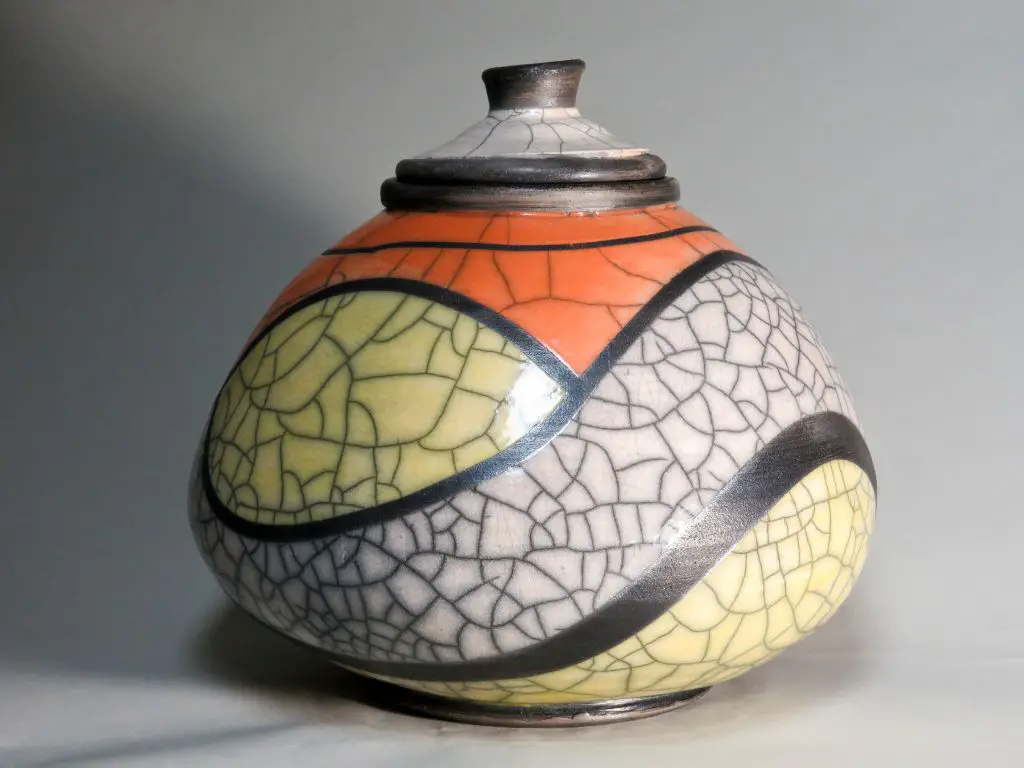What Is The Translation Of Raku?
Raku is a traditional Japanese technique of hand-building and firing pottery that dates back centuries. The term “raku” comes from a Japanese word meaning “enjoyment” or “comfort.” This reflects the philosophy behind raku pottery, which emphasizes spontaneity, simplicity, and an appreciation of natural beauty.
Raku originated in 16th century Japan when a feudal lord commissioned the potter Chōjirō to produce hand-molded tea bowls for use in the Japanese tea ceremony. Chōjirō developed a fast-firing technique by removing pots from the kiln while still glowing hot and placing them directly into containers of combustible materials like leaves or sawdust. This produced dramatic crackled and metallic finishes.
Over the centuries, raku techniques spread across Japan and evolved within different artistic lineages. Today, raku remains a popular technique among studio potters around the world, valued for its rustic aesthetic and distinctive firing process that leaves each piece with a feeling of spontaneity and randomness.
Origin and History
Raku ware originated in late 16th century Japan during the Momoyama period. It was first produced by master potter Chōjirō, who is considered the founder of the Raku family of potters. According to the Raku Museum in Kyoto, Chōjirō originally came from southern China and brought ceramic techniques to Japan. He settled in Kyoto and established the first Raku kiln with the patronage of local tea masters.
The Raku Museum states that Chōjirō invented a fast-firing pottery technique ideal for making tea bowls for the Japanese tea ceremony. This technique involved removing pots from the kiln while still glowing hot and placing them directly into containers filled with combustible materials like leaves or sawdust. This shocked the clay and glazes, creating the signature crackled effects seen on Raku ware [1].
Chōjirō was eventually designated as an official potter for the Toyotomi clan. His fast-firing raku technique allowed tea bowls to be made quickly and cheaply, compared to other ceramic techniques of the time. Chōjirō’s son Jōkei helped expand the influence and popularity of Raku pottery. From its origins in 16th century Kyoto, Raku ware has become one of Japan’s best known ceramic arts.
Raku Pottery Techniques
Raku pottery is known for its unique firing and post-firing processes that result in dramatic surface effects. According to Oxford Clay, raku involves removing the pot from the kiln while it is still glowing hot and placing it into materials like sawdust, leaves, or newspaper which combust and create patterns of carbon and crackle on the surface (https://www.oxfordclay.co.uk/blog-1/what-is-raku-pottery). This rapid cooling and interaction with combustible materials is the hallmark of raku techniques.
Some common raku techniques include (https://potteryinspiration.com/raku-pottery/):
- Naked raku – removing the pot from the kiln and allowing it to cool in open air
- Saggar firing – placing the pot in a container filled with combustibles during firing
- Obvara – covering the pot with aluminum foil or metal can lids during firing
- Horsehair raku – brushing horsehair across the hot pot to create lines and patterns
- Copper matte raku – adding copper carbonate to interact with the clay and create iridescent colors
These techniques allow raku artists to create one-of-a-kind surface effects full of character and spontaneity. The raku process embraces unpredictability and serendipity in a way unique among ceramic techniques.
The Raku Firing Process
The raku firing process involves multiple steps to create the distinctive crackled and metallic finishes characteristic of raku ware:
First, the pottery is bisque fired to around 1800°F to remove any moisture and make the clay body firm and stable (Instructables, n.d.). After bisque firing, raku glazes are applied to the bisqueware. The pottery is then fired in a raku kiln, which heats rapidly to around 1850-1900°F. At peak temperature, the glazed pottery is removed from the kiln using long metal tongs and placed into a metal garbage can filled with combustible materials like sawdust or paper. This process is called ‘reduction’ and it deprives the pottery of oxygen, resulting in unique crackled glaze effects. The pottery is left to cool in the reduction chamber before being removed and brushed or washed to accentuate the crackled effects. Additional materials like copper carbonate can be brushed on to create vibrant metallic finishes.
Firing raku ware requires close control over the kiln atmosphere to achieve the desired results. The rapid heating, reduction, and cooling give raku pottery its distinctive appearance and make the firing process a central part of the raku tradition.
Common Raku Glazes
Raku glazes are formulated to withstand the quick changes in temperature of the raku firing process. The most common raku glazes include:
Turquoise – This glaze contains copper and results in shades of blue, green and turquoise. It has a satiny matte finish. A recipe for a classic turquoise raku glaze can be found at Turquoise Raku Glaze.
Copper Red – Also containing copper, this glaze fires to a reddish color. It can also create areas of purple and blue. A copper red raku recipe is available from Digital Fire.
Crackle Glazes – These glazes contain materials like calcium or magnesium that cause cracking during the raku firing process. Popular crackle glazes include Clear Crackle and NewBatz Crackle. Crackle glaze recipes can be found at Linda Arbuckle Ceramics.
Notable Raku Artists
Raku ware originated in Japan in the 16th century under the influence of master potter Chōjirō and has continued to evolve through the creative expressions of influential artists over the centuries. Some of the most notable Raku artists who have shaped and advanced this pottery tradition include:
Chōjirō (early 16th century) – Known as the founder of Raku ware, he created the first pieces of this style under the patronage of Japanese tea master Sen no Rikyū. His original works featured simple shapes, rustic finishes, and subtle earthy glazes.
Hon’ami Kōetsu (1558–1637) – A renowned calligrapher and potter who collaborated with early Raku masters. He helped establish aesthetic principles like asymmetrical shapes, irregular patterns, and an emphasis on natural beauty.
Ameya (early 17th century)- Son of Chōjirō and another influential early Raku master. He experimented with new techniques like hand-modeling pots and created bolder hues on oxidized wares.
Kichizaemon Raku (1510-1592) – Head of the Raku family workshops in the late 16th/early 17th centuries. He helped codify processes for making standard Raku glazes and firing methods.
Rakusai Tanaka (1885-1979) – A 20th century Raku innovator who played with modern shapes and bright, abstract colors influenced by Western trends.
Paul Soldner (1921-2011) – An American potter who brought Raku techniques to the U.S. and pioneered new approaches like raku in electric and gas kilns.
Yoshitomo Saito (1907-1997) – A Japanese Raku master who pushed the boundaries of traditional techniques with his abstract vessels, metallic lusters, and mixed media collaborations.
From its origins centuries ago to contemporary expressions, Raku ware has been shaped by the creative talents of potters around the world.
Raku in the West
The Raku style of Japanese pottery spread to the West starting in the early 1900s. In Europe, French ceramic artist Bernard Leach brought Raku techniques back after visiting Japan and collaborating with Japanese potters. Leach wrote the book A Potter’s Book in 1940 which helped introduce Raku to the West.
In America, potters such as Paul Soldner and Robert Sperry began experimenting with Raku in the 1950s and 1960s, putting their own spin on the Raku process. Western style Raku often involves more emphasis on spontaneity and abstract expressionism compared to traditional Japanese Raku. Western Raku introduced new glazes, firing methods, and shapes while still drawing inspiration from classic Japanese Raku.
By the 1970s, Raku had spread through the studio pottery movement and became widely embraced by Western ceramic artists. Today it remains a popular technique in Europe and North America among potters and ceramic artists. Raku firing events and workshops are common as the hands-on process and dramatic results appeal to potters trained in the Western ceramic arts tradition.
Contemporary Raku
Raku has continued to evolve and take new forms in contemporary art. While staying true to the traditional raku firing process, today’s raku artists have expanded the techniques and aesthetics of raku pottery. There is an emphasis on experimentation, with many contemporary raku artists embracing more abstract, avant-garde styles.

Some defining features of contemporary raku include:
- Large scale, sculptural forms beyond traditional vessel shapes
- Unexpected surface textures and patterns
- Bold, spontaneous imagery and brushwork
- Unconventional glazing and post-firing treatments
- Unique raku firing methods such as pit firing or smoke firing
Many contemporary raku artists also incorporate mixed media into their works, like wood, metal, stone aggregates, or found objects. There is an emphasis on individual expression and innovation over tradition. While contemporary raku preserves the distinctive cracked, crazed effects of traditional raku, the works tend to have a more modern, avant-garde aesthetic.
Some notable contemporary raku artists include Mark Hines, who creates abstract sculptural forms often combining raku with wood or stone. Other leading artists are Paul Soldner, Suzan Landolphi, and Don Ellis. Their works showcase the diversity of contemporary raku today. From bold, graphic brushwork to innovative techniques like horse hair raku, current raku art represents a contemporary evolution of this historic pottery process.
The Meaning of Raku
The Japanese word “Raku” (楽) translates to “enjoyment,” “comfort,” or “ease” (Merriam-Webster, 2022). This term was chosen to describe a style of Japanese pottery first developed in the 16th century because it represents the zen philosophy behind its creation and the process of firing raku ware.
Raku pottery emphasizes spontaneity, simplicity, and natural beauty. According to tradition, the pieces are shaped by hand rather than thrown on a potter’s wheel, fired at low temperatures around 1740–1830°F, and subject to little manipulation by the artist so the fire can leave its own distinctive imprint on the clay (Soul Ceramics, 2022).
The raku firing process itself is meant to be quick and experimental. Pieces are removed from the hot kiln and subjected to smoking or quenching to achieve unique patterns of crackling, crazing, coloring and sheen. This unstructured approach aligns with the wabi-sabi aesthetic in Japanese culture that finds beauty in imperfection and transience.
Thus, the word “raku” poetically captures the spirit of freedom, spontaneity, and harmony with nature associated with this style of Japanese pottery.
Conclusion
In summary, Raku ware has a long and storied history, originating in Japan in the 16th century. The unique Raku firing process, characterized by removing the pottery from the kiln while at peak temperature and placing it into materials like sawdust that causes rapid cooling and produces distinctive crackle effects, is what defines Raku ware. While traditionally Raku was simple tableware, contemporary Raku artists have elevated it to an expressive art form. The meaning behind the word “Raku” refers to “enjoyment” and “comfort,” reflecting Buddhist philosophy. Raku pottery is greatly admired for its simple and rustic beauty as well as its embodiment of wabi-sabi aesthetics. The Raku tradition has spread worldwide, and continues to be practiced and reinvented by potters today. Raku ware leaves a lasting impact on those who experience it, conveying a sense of tranquility and an appreciation for natural imperfection.


